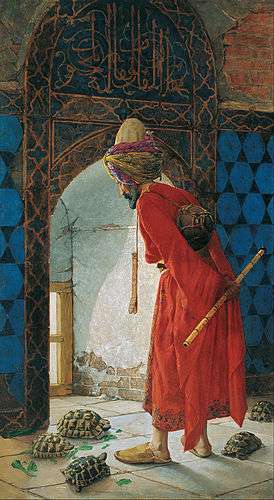The Tortoise Trainer
| Turkish: Kaplumbağa Terbiyecisi | |
 | |
| Artist | Osman Hamdi Bey |
|---|---|
| Year | 1906 |
| Medium | oil on canvas |
| Dimensions | 2,215 mm × 1,200 mm (87.2 in × 47.24 in) |
| Location | Pera Museum, Istanbul |
The Tortoise Trainer (Turkish: Kaplumbağa Terbiyecisi) is a painting by Osman Hamdi Bey which was crafted in 1906 and 1907 (two versions). In 2004 it was sold for $3.5M and is currently displayed at the Pera Museum in Istanbul.
In the Tortoise Trainer, Osman Hamdi Bey satirises the slow and ineffective attempts at reforming the Ottoman Empire, through the attempts of an anachronistic historical character to train tortoises. The painting depicts an elderly man in traditional Ottoman religious costume which predates the introduction of the fez and the spread of Western style dress with the Tanzimat reforms in the mid 19th century. He holds a traditional ney flute with which he is attempting to "train" the tortoises at his feet.
Historic context
Osman Hamdi Bey created the painting at a time of great social and political turmoil in the Ottoman Empire. The reforms introduced by Sultan Abdülhamid II had either proved ineffective, or had been blamed for the increased upheaval. The Ottoman Empire, which still encompassed parts of the Balkan peninsula, parts of North Africa, all of Anatolia and the Levant, and much of the Arabian peninsula at the turn of the 20th century, was under serious threat from both the growing power of nationalist movements within its territory, and from the incursions of foreign powers which would eventually divide the empire between them in the aftermath of the First World War.
Although not widely shown or understood at the time, the painting achieved greater significance in subsequent decades as it presaged the Young Turk Revolution of 1908 which brought an end to the direct autocratic rule by the Sultan (replaced by the regime of the Three Pashas after the 1913 coup d'état) and set the stage for the Empire's entry into the First World War on the side of the Central Powers and for its subsequent partitioning.
References
- "The Tortoise Trainer" at the Pera Museum, Istanbul.